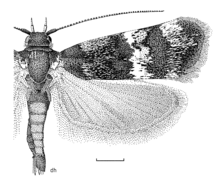Hierodoris polita
| Hierodoris polita | |
|---|---|
 | |
| Scientific classification | |
| Kingdom: | Animalia |
| Phylum: | Arthropoda |
| Class: | Insecta |
| Order: | Lepidoptera |
| Family: | Oecophoridae |
| Genus: | Hierodoris |
| Species: | H. polita |
| Binomial name | |
| Hierodoris polita Hoare, 2005[1] | |
Hierodoris polita is a species of moth in the family Oecophoridae. It is endemic to New Zealand. This species is classified as "At Risk, Naturally Uncommon" by the Department of Conservation.
Taxonomy
This species was first described by Robert J. B. Hoare in 2005 and named Hierodoris polita.[1] Prior to its scientific description H. polita was known as H. ‘silver banded’.[2] The holotype specimen, which was collected by John S. Dugdale at Craig Flat, Clutha Valley on 16 March 1986, is held at the New Zealand Arthropod Collection.[2]
Description
The wingspan of the male of the species is between 11-14.5 mm and the female is between 12.5-13.5 mm.[2]
H. polita is very similar in appearance to its close relatives Hierodoris frigida and H. extensilis.[3] It can be distinguished from H. frigida as H. polita lacks the all-yellow segment 2 of the labial palp as well as the yellowish white spot that H. frigida has on its costa.[2] H. polita has white scales on the posterior part of the tegulae where as H. frigida has a dark tegulae.[2] H. polita also has a white transverse band on the forewing that H. frigida lacks.[2]
H. polita can be distinguished from H. extensilis as the later has a white base to the hindwing whereas H. polita has a bronzy base.[3] The exterior surface of the labial palpi of H. extensilis is white-scaled whereas H. polita is dark-scaled.[3] H. polita also has a transverse white forewing fascia which both H. extensilis and H. frigida lack.[3]
Distribution
This species is endemic to New Zealand.[1][4] It can only be found in the South Island in the Central Otago and Dunedin areas.[2] H. polita is classified as range restricted indicating its local distribution.[5]
Biology and behaviour
Although larvae of this species have not been conclusively identified, a likely specimen was collected in leaf litter consisting of detritus of Grimmia laevigata.[2] It has therefore been hypothesised that the larvae of H. polita is a detritivore.[2] The species has been found on the wing in October, November, and January to March.[2]
Habitat and host species
This species is known to prefer open habitat and has so far mainly been collected at south-facing rocky bluffs upon which grow species of Grimmia moss.[2]
Conservation Status
This species has been classified as having the "At Risk, Naturally Uncommon" conservation status under the New Zealand Threat Classification System.[5]
References
| Wikimedia Commons has media related to Hierodoris polita. |
| Wikispecies has information related to Hierodoris polita |
- 1 2 3 "Hierodoris polita Hoare, 2005". www.nzor.org.nz. Landcare Research New Zealand Ltd. Retrieved 23 May 2018.
- 1 2 3 4 5 6 7 8 9 10 11 Hoare, R. J. B. (2005). "Hierodoris (Insecta: Lepidoptera: Gelechioidea: Oecophoridae), and overview of Oecophoridae" (PDF). Fauna of New Zealand. 54: 1–102. ISBN 0478093780.
- 1 2 3 4 Hoare, R. J. B. (March 2012). "A new species of Hierodoris Meyrick (Lepidoptera: Oecophoridae) with a telescopic ovipositor, from granite sand plains in Fiordland". New Zealand Entomologist. 35 (1): 51–57. doi:10.1080/00779962.2012.651776. (subscription required)
- ↑ Gordon, Dennis P., ed. (2010). New Zealand inventory of biodiversity. Volume two. Kingdom animalia : chaetognatha, ecdysozoa, ichnofossils. Vol. 2. Christchurch, N.Z.: Canterbury University Press. p. 462. ISBN 9781877257933. OCLC 973607714.
- 1 2 Hoare, R.J.B.; Dugdale, J.S.; Edwards,, E.D.; Gibbs, G.W.; Patrick, B.H.; Hitchmough, R.A.; Rolfe, J.R. (2017). "Conservation status of New Zealand butterflies and moths (Lepidoptera), 2015" (PDF). New Zealand Threat Classification Series. 20: 8.